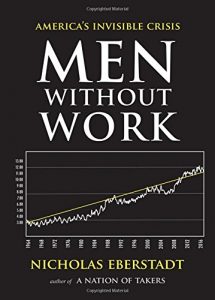The number of men age 25-54 not in the labor force (NILFs, get it?) has reached a shockingly high figure — about 7 million, or about the same percentage as at the end of the Depression in 1940. This number doesn’t even include men who are in prison, students, or stay-at-home dads.
Demographer Nick Eberstadt, who authored the new book, Men Without Work, says that one in six working-age men in America are jobless, and if the trend continues, that number will go to one in five jobless men in America in a generation.
“These detached men live and walk among us, though without productive economic purpose — as they endure an overlooked, modern-day Depression,” Eberstadt says.
This increase in male NILFs is a reality across the developed world, but the increase is especially high in the United States. Trying to come up with an explanation why has become something of a parlor game for economists and social scientists. Among some of the explanations — trade sending jobs away, technology automating jobs, federal benefits that make work less desirable or necessary, even video games, which have driven a rise in couch potatoes.
Eberstadt argues that the problem stems not from the number of men in prison, but from the number of men who have previously been in prison. About 12 percent of the adult male civilian population currently not in jail has been convicted of a felony.
A single variable — having a criminal record — is a key missing piece in explaining why work rates and LFPRs [labor-force participation rates] have collapsed much more dramatically in America than other affluent Western societies over the past two generations. This single variable also helps explain why the collapse has been so much greater for American men than women and why it has been so much more dramatic for African American men and men with low educational attainment than for other prime-age men in the United States.
Eberstadt notes that African-American men are twice as likely to constitute this American “un-worker” than whites or Latinos, which is not surprising since African-Americans make up about 40 percent of the prison population even though they are only 13 percent of the overall U.S. population. That compares to whites who are 64 percent of the U.S. population, but 39 percent of the prison population, and Latinos who are 16 percent of the U.S. population, but 19 percent of the prison population.
Eberstadt offers some solutions to the problem. He notes that former prisoners have paid their debt to society so need to be welcomed back into society. He calls it a “shameful reflection of our ignorance” that we have marginalized ex-prisoners, much less failed to stop the triggers that lead people to commit the offenses that land them in prison in the first place.
He notes that welfare reform worked in the 1990s to get single mothers into the workforce, and that disability insurance programs should be predicated on a “work first” incentive rather than the current system, which spends hundreds of billions of dollars a year to encourage men to sit on the sidelines.
Revitalizing American business, and avoiding a trade war, will also keep employment rates from further declining, he says, not to mention public policies that make marriage a more attractive option since married men with kids are much more likely to be in the workforce than unmarried, childless men.






